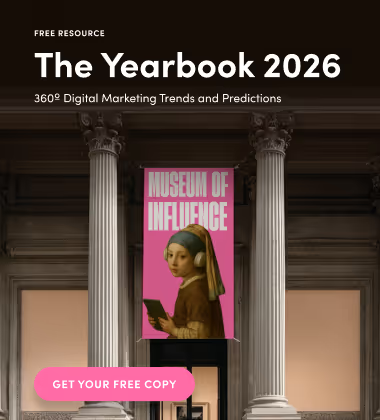Learn how to use ChatGPT prompts to uncover search intent, enhance content strategy, and boost conversions. Discover how intent-driven analysis strengthens SEO, improves user experience, and helps marketers create content that resonates with audiences at every stage of their journey.
In the relentless pursuit of digital relevance, marketers and SEO professionals have long relied on keyword research to capture traffic. But volume and competition metrics only tell half the story.
The real challenge lies in understanding the why behind the search: the user's intent. This crucial layer of insight dictates whether content resonates or repels, leading to engagement or a bounce.
With search engines like Google processing over 8.3 billion searches a day, failing to meet user intent is a monumental missed opportunity. Today, a new class of AI tools, spearheaded by ChatGPT, offers an unprecedented ability to decode this human element, transforming how we approach content strategy.
Why is search intent important for SEO and content strategy?
Understanding search intent is the bedrock of modern SEO. It’s the difference between attracting passive browsers and engaging qualified prospects. When your content aligns with a user's underlying goal, whether to learn, compare, or buy, you satisfy their needs, which Google rewards with higher rankings. This alignment directly impacts traffic quality, user experience, and ultimately, conversions.
Using ChatGPT for deeper intent discovery
Traditional keyword tools provide quantitative data, but ChatGPT offers a qualitative understanding. By processing language with human-like nuance, it can infer the context, motivation, and potential pain points behind a search query. This shifts your analysis from a simple keyword match to a nuanced interpretation of user needs, enabling a more strategic approach to content creation.
How to use prompt engineering for precise search intent analysis
To unlock ChatGPT's analytical power, your prompts must be precise. The core principles are clarity, context, and constraint.
- Be explicit about the keyword, target audience, and type of analysis needed.
- Provide context, such as your business goals or a competitor's website, and constrain the output format (e.g., "list," "table," "summary") for actionable results.
A well-structured prompt acts as a blueprint for the AI. This structure minimizes ambiguity and maximizes the quality of the insights.

Image source: Shutterstock
ChatGPT prompts for categorizing basic search intent
Unlocking search intent to improve your SEO performance starts at the root: understanding and categorizing the context surrounding it. Start with these prompts for basic search intent.
Classify the core intent type
First, categorize the keywords into the primary intent types. What were users’ intentions behind the search? Is it informational, navigational, commercial, or transactional?
With informational intent dominating over 52% of searches, accurately identifying it is key to differentiating your content from the crowd.
- Prompt: For the keyword "[sustainable running shoes]," classify the primary search intent (Informational, Navigational, Commercial, Transactional). Explain your reasoning in one sentence.
Contextualize keywords through prompt-driven analysis
Classifying the intent is one thing, but understanding the user's mindset is another. After all, a single keyword can carry multiple layers of intent depending on the user's journey.
- Prompt: Analyze the keyword "[best CRM for small business]." What specific questions is a user likely trying to answer? What are their potential pain points?
Use prompts for SERP feature analysis to infer intent
The Search Engine Results Page (SERP) is a direct reflection of what Google believes satisfies user intent. Use ChatGPT to analyze these clues.
- Prompt: A SERP for the keyword "[how to bake sourdough bread]" shows video carousels, a featured snippet with steps, and a "People Also Ask" box. What does this tell us about the dominant search intent?
ChatGPT prompts for advanced intent analysis
Once you’ve established the foundation, delve deeper for a more personalized study.
Identify micro-intent and nuance beyond broad categories
Users rarely fit neatly into a single category. Advanced prompts can uncover subtle "micro-intents" that reveal more specific needs, such as comparing features, seeking validation, or troubleshooting a problem.
- Prompt: Beyond the primary commercial intent for "[mattress in a box]," what are three potential micro-intents a user might have? (e.g., comparing return policies, seeking eco-friendly options, looking for financing).
Map intent across the customer journey and user personas
Tailor your analysis to specific customer segments. By providing a user persona, you guide ChatGPT to deliver more relevant and empathetic insights.
- Prompt: Act as a budget-conscious college student. Analyze the search intent for "[cheap healthy meals]." What are your primary concerns, and what kind of content would be most helpful?
Discover emerging intent and industry trends
Use ChatGPT to explore beyond existing keywords and predict future search behavior. This proactive approach keeps your content strategy ahead of the curve.
- Prompt: Based on recent AI news, what are some emerging search intents related to the topic "AI tools for marketers"? List 5 potential long-tail keywords and their likely intent.

Image source: Shutterstock
ChatGPT prompts for content strategy and optimization
Turn your insights into optimized content with these prompts.
Develop intent-driven content outlines and briefs
Translate your analysis into actionable blueprints for content creation. An intent-driven outline ensures every section of your article serves a specific user need.
- Prompt: Create a blog post outline for the keyword "[how to start a podcast]" targeting an informational intent. Include H2s and H3s that address common beginner questions and challenges.
Optimize existing content and content creation for specific intent
Review your current website content for intent misalignment. A page optimized for informational queries will fail if it's attracting users with transactional intent. Use ChatGPT to identify these gaps and suggest improvements.
- Prompt: My blog post on "[digital camera reviews]" has a high bounce rate. Analyze the title and meta description below and suggest revisions to better align with the commercial investigation intent.
Enhancing E-E-A-T through intent alignment
Meeting search intent is fundamental to demonstrating E-E-A-T (Experience, Expertise, Authoritativeness, Trustworthiness). When you provide genuinely helpful, expert content that directly answers a user's query, you build trust with both your audience and search engines.
- Prompt: Analyze the top 10 search results for the keyword ‘small business cyber insurance’. Identify the dominant search intent and suggest how to structure a blog post that demonstrates strong E-E-A-T through expert advice, authoritative sources, and trustworthy tone.
Inform broader content strategy and topic clusters
Use intent analysis to build robust topic clusters. By understanding the web of related informational, commercial, and transactional queries around a pillar topic, you can create a comprehensive resource that captures traffic at every stage of the user journey.
- Prompt: Generate a topic cluster around the pillar keyword ‘influencer marketing strategy’. Include at least five supporting blog topics for each intent type (informational, commercial, and transactional), and explain how each supports the overall SEO and content strategy.

Image source: Canva
Prompts for analyzing intent gap and competitive advantage
Intent gaps are prime real estate for brands looking to stand out. See opportunities for your growth and weed out competitors below:
Identify competitor intent gaps and opportunities
Analyze top-ranking competitor pages to see how they’re satisfying user intent, and where they fall short. This reveals valuable opportunities for you to create superior content.
- Prompt: Analyze the top 3 SERP results for "[project management software comparison]." What aspects of user intent do they cover well, and what questions or comparison points are they missing?
Discover underserved long-tail keywords with specific intents
Long-tail keywords often represent highly specific, underserved intents. Use ChatGPT to brainstorm these queries and build content that captures this high-quality traffic.
- Prompt: Generate a list of 10 long-tail keywords related to "[remote team collaboration]" that reflect a specific transactional or commercial intent.
Maximize user experience and conversions with intent-driven insights
Optimize landing pages and product descriptions for specific intent
Ensure your most important pages speak directly to the visitor's goal. A product page should address commercial and transactional intent by highlighting features, benefits, pricing, and trust signals, leading to higher conversions.
- Prompt: Review this product page copy for [insert product or service]. Identify the dominant search intent and suggest improvements to better align with commercial and transactional goals, focusing on clarity, conversion-focused language, and elements that build trust.
Enhance overall website user experience (UX)
A website structured around user intent is intuitive and easy to navigate. When users find what they're looking for quickly, satisfaction increases, bounce rates decrease, and your site's authority grows.
- Prompt: Analyze the navigation and content layout of this website [insert URL]. Suggest UX and content structure improvements based on user intent categories (informational, commercial, transactional) to improve engagement and reduce bounce rates.”
Drive qualified leads, sales, and marketing campaigns
Ultimately, aligning your entire digital presence with search intent drives business results. From crafting ad copy to designing email nurture sequences, understanding user motivation is key to creating marketing campaigns that convert.
- Prompt: Develop a multi-channel marketing plan for [insert product or service] that targets user intent stages, including awareness, consideration, and decision. Include examples of ad copy, landing page messaging, and email subject lines tailored to each stage.

Image source: Canva
ChatGPT prompts for integrating intent in structured data
Structured data improves your chances of landing a featured snippet on SERP. Knowing your intent allows you to sharpen your message.
Generate schema markup for clear intent signaling
Use ChatGPT to generate structured data (like FAQ or How-to schema) that explicitly tells search engines about your content's purpose. This can improve your SERP visibility with rich snippets, directly communicating your intent alignment.
- Prompt: Based on the following FAQs about our software, generate the appropriate FAQPage JSON-LD schema markup.
Integrate intent with website architecture and XML sitemaps
A logical site structure, guided by intent-based topic clusters, helps both users and search engine crawlers understand your website's hierarchy and expertise. This clarity can improve crawl efficiency and reinforce your site's topical authority.
- Prompt: Analyze this website’s sitemap [insert URL or XML file] and suggest improvements to align it with user intent categories (informational, commercial, transactional). Recommend internal linking and structured data markup strategies that strengthen topical relevance and crawlability.
Key takeaways
FAQs
Meet search intent with SEO content geared to rank
Moving beyond simple keyword metrics to a deep understanding of search intent is no longer optional; it’s the core of effective SEO and content strategy. AI tools like ChatGPT provide an unprecedented opportunity to analyze user motivation at scale, bridging the gap between data and human psychology. Mastering prompt engineering enables ChatGPT to become an analytical partner.
Our content creation experts at The Influence Agency can help you craft high-quality content using reliable AI tools and platforms. Ready to give your brand a boost? Let’s talk strategy.



